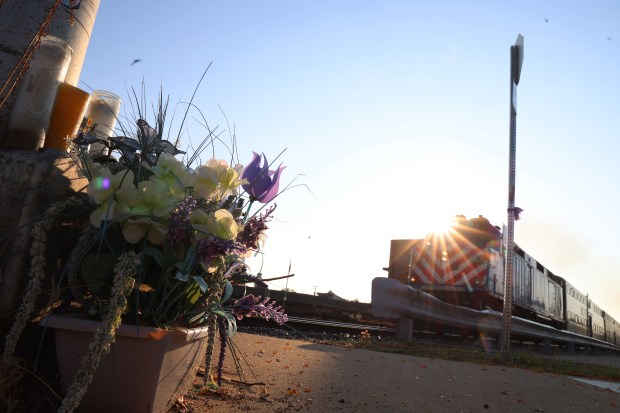Two railroad lines, two tragedies. Two young women who were killed by trains while walking across the tracks in the Chicago area this year were not the first victims on those lines — but no pedestrian crossing gates had been added at the sites in question.
Months later, no new gates have been put up. Authorities say they are working on it, though it’s unclear when they might be installed.
While road-rail crossings in the Chicago area typically have gates to stop vehicles, there often are no such protections for pedestrians.
Of 971 rail crossings with roadway gates in Cook and the collar counties of DuPage, Kane, Lake, McHenry and Will counties, only an estimated 204, or 21%, have pedestrian gates, according to the Illinois Commerce Commission, which regulates crossings.
Nationally, pedestrian incidents and fatalities are rising at a higher level when compared to overall accidents at crossings. While overall accidents at rail crossings increased 15% from 2020 to 2023, the number of pedestrian incidents increased 20%, and the number of pedestrian fatalities increased 31%, according to federal data.
Though the ICC does not have data on the number of road-rail crossings in Illinois with adjacent pedestrian crossings, advocates say that where such crossings exist, more safety is needed.
“There should be pedestrian gates at all crossings where pedestrians are using them,” said attorney Jim Pullos, who has filed suit in one of the recent local cases.
Walkers typically are much closer to trains, which can extend 3 feet beyond the tracks on both sides. In many cases, one train passes before the victims began crossing the tracks, when another train from the other direction, its noise possibly drowned out by the first train, comes unexpectedly. Pedestrian gates could help prevent such accidents by staying down when a second train is coming.
Two recent fatalities, in northwest suburban Barrington and Chicago’s Hegewisch community, involved such circumstances, authorities said.
Seventeen-year-old Marin Lacson was killed on a foggy morning in January while walking to high school on Illinois Route 59 where it crosses Metra’s Union Pacific (UP) Northwest line. There was no pedestrian gate to warn or stop her.
Her family filed suit Wednesday against Metra, Union Pacific and Barrington. Marin’s father, Mike Lacson, issued a statement saying the family was “devastated” by her death, but wants to make sure safety improvements are made so she will not have died in vain.
“As we learn more details about Marin’s death, we are truly shocked and saddened by the lack of action by those responsible for the safety of our community,” he said. “It is utterly distressing that basic safety measures were ignored for years and continue to be ignored.”
As with many crossings, Barrington is in a “quiet zone,” which means that train horns are not to be sounded except at the operator’s discretion.
“Marin’s death was entirely preventable,” Pullos said.
On the other side of Chicago’s extensive rail network, in 2021, a woman was killed when she was struck by a train while crossing the South Shore Line tracks in Hammond.
This summer, 22-year-old Grace Bentkowski was killed when she was struck by a train while walking across the same line at the station in nearby Hegewisch on Chicago’s Far Southeast Side.
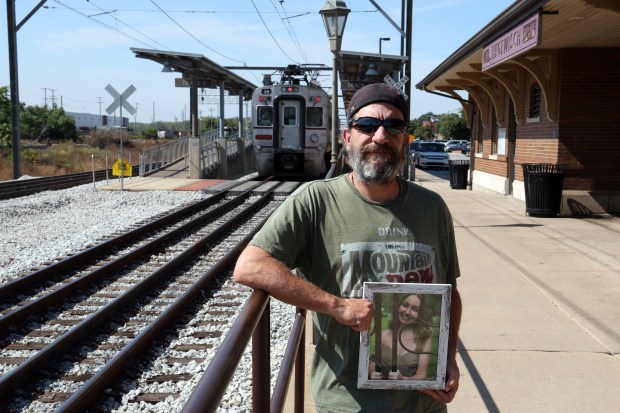
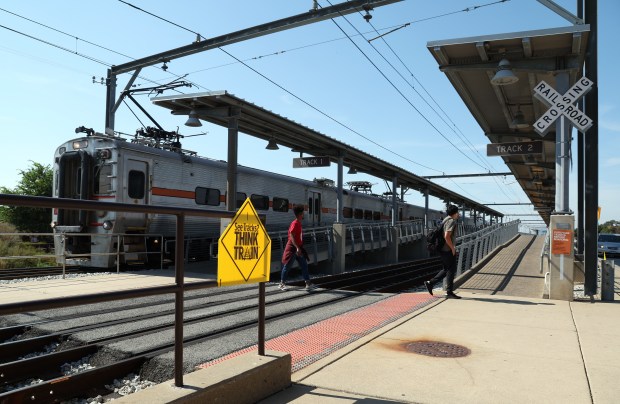
Bentkowski’s father, Phil Bentkowski, thought the South Shore operators would have installed gates, lights and a horn at its crossings after the previous accident in Indiana, but he said neither station has them.
“Maybe if something were done, my daughter would still be here,” Phil Bentkowski said. “Since I can’t get my daughter back, the next best thing I can do is save someone else’s.”
That’s why the Bentkowski family has started an online petition to bring safety improvements to both stations.
The accident that took the life of Bentkowski, a creative producer for NewsNation, was one among many recurring tragedies on the nation’s rails. Though rail collisions plummeted 82% between 1972 and 2019, nationwide, a person or vehicle is hit by a train on average every three hours, according to Operation Lifesaver, which campaigns to prevent rail deaths. That amounted to 1,775 deaths and injuries nationwide, 2023 federal statistics showed.
In Barrington, records show several accidents have occurred over the years at the Route 59 crossing. In 2013, an 11-year-old student lost a foot when he was hit by a train near Route 59. His mother had called for pedestrian gates at the time, and there are two on Lake-Cook Road, but they were never put up on Route 59.
In Illinois, one of the complicating factors is that a mix of agencies are responsible for improving crossing safety.
Village officials told the Tribune they have secured $1.1 million from the Illinois Commerce Commission to install pedestrian gates at the Metra crossings on Route 59, and Hillside Avenue at U.S. Route 14, and additional gates on Lake-Cook Road.
The village has met on-site multiple times with the ICC, Union Pacific (UP) Railroad, and the Illinois Department of Transportation (IDOT) to evaluate conditions and review the proposed work. While village leaders had hoped to simply add pedestrian gates, the other agencies maintain that all of the gates, including existing ones, need to be replaced to meet UP and federal regulations at the Route 59 and Lake-Cook crossings, which will take longer.
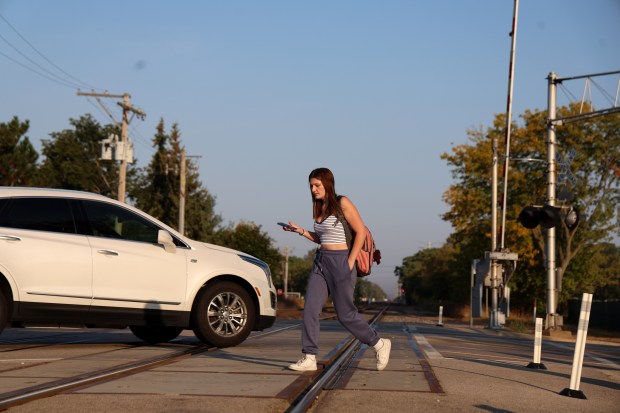
Officials also plan to dig a pedestrian underpass under Lake-Cook Road at a freight train crossing near Barrington High School, and have obtained $500,000 for a preliminary design feasibility study to begin late next year.
Before then, IDOT and Canadian National Railway are coordinating the installation of pedestrian gates at that crossing late this year.
The village also worked for more than a decade to get a roadway underpass that’s being built on Route 14 under the CN tracks, eliminating the ground-level crossing. The village and Metra also held rail safety sessions for residents and students.
“The village of Barrington has always made safety a priority, maintaining a strong working relationship and a long history with the ICC, IDOT and railroad agencies,” spokeswoman Becky Wyskochil wrote to the Tribune. “In fact, in the summer of 2023, the village collaborated with the state and CN to install pedestrian gates as part of a railway-led grade crossing renewal and vehicular gate replacement project. This effort resulted in full pedestrian gate control at the CN crossing on Hough Street (Route 59).”
The village also worked to get pedestrian gates at the Union Pacific crossing at nearby Hart Road in 2021.
After the recent tragedy, residents formed the Barrington Student Safety Organization, to push for safety improvements. In response, the village hired four more crossing guards and raised their pay, and has safety monitors at four crossings in town. Additional signage and pavement markings were installed in February.
Attorney Roma Khan, president of the organization, asked for the village to do more. After the previous accident, she said, “They dropped the ball because the community stopped asking for it. We want to prioritize this. I will not let this go until gates are installed.”
Metra issued a statement that it has been installing pedestrian gates on sidewalks for about five years as it renews road crossings. With roughly 270 crossings on Metra-owned lines, while renewing about five to 10 crossings a year, it will take time to get to every crossing. Roughly a fourth to a fifth of those have pedestrian gates now.
Metra rules do not allow one train to enter a station when another train going the other direction is already there, unless there are provisions at the station to prevent pedestrians from crossing the tracks (such as intertrack fencing) or there is a safe route across (such as a pedestrian tunnel or an overpass).
Union Pacific Railroad, which owns and operates Metra’s Northwest line, issued a statement that it hadn’t had a chance to review the lawsuit, but stated, “At Union Pacific, safety is the key foundational pillar of everything we do. Our thoughts are with the Lacson family and community impacted.”
In Hegewisch, the Northern Indiana Commuter Transportation District (NICTD), which runs the South Shore Line, issued a statement expressing its condolences to the Bentkowskis, and reminded people to look both ways before crossing. It also announced that it hired an engineering firm to analyze its stations and recommend what safety improvements should be made.
“We expect to receive the diagnostic report within the next 90 days and are committed to securing the necessary funding to implement safety enhancements as soon as possible,” railroad officials said in a statement.
As a national rail hub, Illinois is second only to Texas in the number of public roadway-rail crossings, at about 7,500. Following accidents, people often question which towns get crossing improvements and which don’t.
The state Commerce Commission prioritizes projects based on factors such as safety of the existing crossing, collision history, traffic volume, engineering requirements and geographical location, spokeswoman Cayli Baker said.
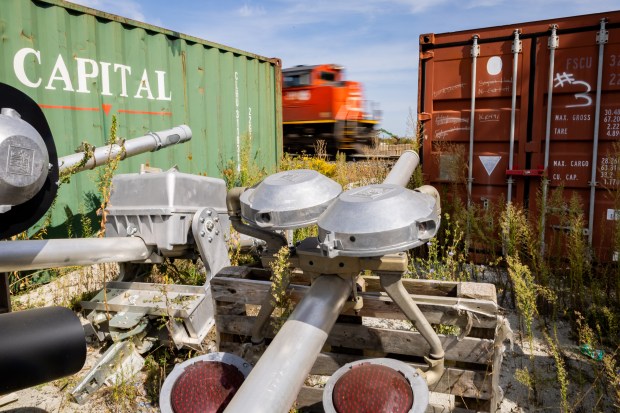
The approval process typically entails staff recommendations sent to the agency’s five commissioners, who then vote on whether to approve any funds. The money comes from the state’s Grade Crossing Protection Fund, which generates around $40 million a year from the state road fund.
The latest five-year plan calls for improving 1,261 at-grade crossings with upgrades to warning devices, while 22 will get an underpass or overpass, and six will get new pedestrian grade separations such as bridges or tunnels.
The commission is also involved in warning about the dangers of highway-rail grade crossings, in part through Operation Lifesaver, encouraging people to always look both ways before crossing tracks.
Applications for crossing improvements may be submitted on the grade crossing website, at https://www.icc.illinois.gov/rail-safety/crossing-safety-improvement-program.
“We’re in the 21st century, safety is a very big thing,” Phil Bentkowski said. “How trains can slide under radar is beyond me.”
This week is See Tracks? Think Train Week, and Friday is #RedOutforRailSafety Day, when Operation Lifesaver asks people to show support by wearing red and sharing photos online.


